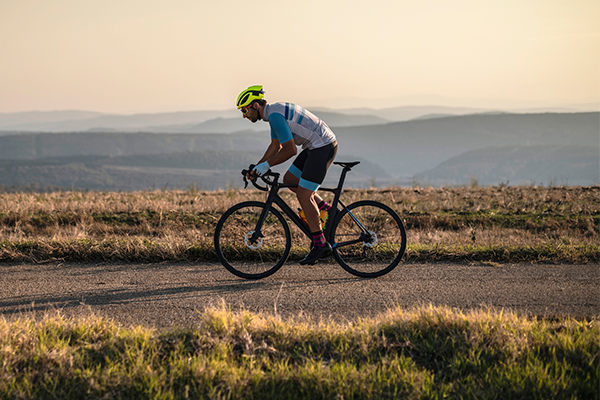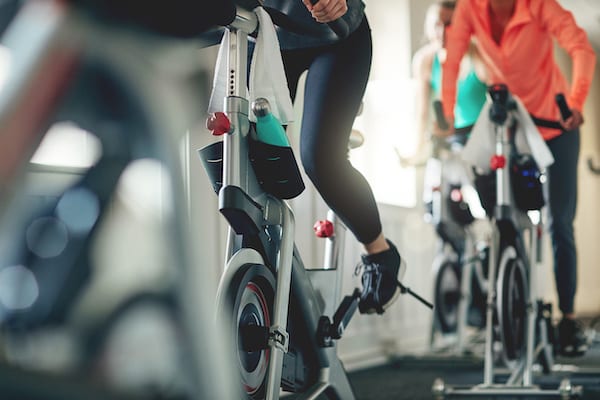How Many Calories Does Biking Burn?

Wondering how many calories you’re burning on your bike commute to work or weekend trail ride, or whether bicycling can help you with weight loss?
Read on to find out how many calories you can expect to burn riding a bike.
Calories Burned Biking: Outdoor
When we were kids, getting around and bikes just went foot in pedal.
We may not live on our bicycles anymore, but there are numerous benefits to biking for exercise, transportation, and fun.
Bicycling is an exercise that offers both a cardiorespiratory and muscular workout with low impact to joints and knees.
It can decrease stress, and you can easily speed up or slow down depending on your fitness level and goals.
Calories burned road biking

While you won’t get the same calorie-burning benefits during a leisurely bike commute that you would mountain biking, you can burn crazy cals on the road if you’re pedaling with enough intensity.
But say your commute is 15 minutes each way, and you weigh 150 pounds, you can still burn 232 calories just getting to work and back.
Better still, you won’t have to pay for parking.
Light effort (10 to 11.9 mph avg.) for 1 hour:
| Weight | 100 lbs | 125 lbs | 150 lbs | 175 lbs | 200 lbs | 225 lbs | 250 lbs |
| Calories | 309 | 386 | 464 | 541 | 618 | 696 | 773 |
Moderate effort (12 to 13.9 mph avg.) for 1 hour:
| Weight | 100 lbs | 125 lbs | 150 lbs | 175 lbs | 200 lbs | 225 lbs | 250 lbs |
| Calories | 364 | 455 | 546 | 636 | 727 | 818 | 909 |
Vigorous effort (14 to 15.9 mph avg.) for 1/2 hour:
| Weight | 100 lbs | 125 lbs | 150 lbs | 175 lbs | 200 lbs | 225 lbs | 250 lbs |
| Calories | 455 | 568 | 682 | 796 | 909 | 1,023 | 1,136 |
Calories burned mountain biking

Navigating all those hills, inclines, and declines inherent to mountain biking leads to a more strenuous workout than a simple pedal across town.
A typical person weighing 150 pounds can expect to burn 477 calories in a half-hour pedaling uphill, and a whopping 715 calories in 45 minutes.
Of course, since the typical mountain biking experience also includes coasting down hills, your burn may vary.
General, for 1 hour:
| Weight | 100 lbs | 125 lbs | 150 lbs | 175 lbs | 200 lbs | 225 lbs | 250 lbs |
| Calories | 386 | 483 | 580 | 676 | 773 | 869 | 966 |
Uphill, vigorous, for 1/2 hour:
| Weight | 100 lbs | 125 lbs | 150 lbs | 175 lbs | 200 lbs | 225 lbs | 250 lbs |
| Calories | 318 | 398 | 477 | 557 | 636 | 716 | 796 |
Competitive, racing, for 1 hour:
| Weight | 100 lbs | 125 lbs | 150 lbs | 175 lbs | 200 lbs | 225 lbs | 250 lbs |
| Calories | 727 | 909 | 1,091 | 1,273 | 1,455 | 1,636 | 1,818 |
Calories burned BMX biking

BMX biking doesn’t deliver quite the same burn as a vigorous trail biking experience with lots of hills, but this fun sport still packs a large calorie-burning punch: a 150-pound individual can expect to burn 580 calories in an hour.
General, for 1 hour:
| Weight | 100 lbs | 125 lbs | 150 lbs | 175 lbs | 200 lbs | 225 lbs | 250 lbs |
| Calories | 386 | 483 | 580 | 676 | 773 | 869 | 966 |
Calories Burned Biking: Indoor

Indoor biking is a great alternative to outdoor biking during inclement weather. Stationary-bike workouts offer the benefit of being better able to customize as well as monitor for results.
And you’ll find a variety of indoor biking classes at many gyms, health clubs, and spin studios.
Light to moderate effort (51 to 89 watts), for 1 hour:
| Weight | 100 lbs | 125 lbs | 150 lbs | 175 lbs | 200 lbs | 225 lbs | 250 lbs |
| Calories | 218 | 273 | 327 | 382 | 436 | 491 | 546 |
Moderate to vigorous effort (90 to 100 watts), for 1 hour:
| Weight | 100 lbs | 125 lbs | 150 lbs | 175 lbs | 200 lbs | 225 lbs | 250 lbs |
| Calories | 309 | 386 | 464 | 541 | 618 | 696 | 773 |
Vigorous effort (101 to 160 watts), for 1 hour:
| Weight | 100 lbs | 125 lbs | 150 lbs | 175 lbs | 200 lbs | 225 lbs | 250 lbs |
| Calories | 400 | 500 | 600 | 700 | 800 | 900 | 1,000 |
Factors Affecting Calories Burned Biking
Your weight and the method of biking are just two variables that will affect calories burned, among other factors.
For example, if you keep pumping your legs during declines, you’ll burn more calories than if you simply coast.
Likewise, you’ll burn more fat if you mix up speed and intensity.
Steady-state exercise (peddling at low to moderate intensity throughout your workout) is a good way to increase cardiovascular health.
But high-intensity interval training (HIIT) — alternating periods of intense effort and rest — is just as effective in that regard, and perhaps even better when it comes to losing weight.
The caveat: You have to be healthy enough to do HIIT safely and effectively, so work your way up to it.
How to Calculate Calories Burned Biking

You can calculate your own caloric burn following these steps:
- Look up the metabolic equivalents (METS) for the method(s) of biking you’d like to do in Arizona State University’s Compendium of Physical Activities.
- Use Cornell University’s METS-to-calories calculator to convert the number from Step 1 to calories burned.
That figure may only be an estimate, but knowing that you just burned a few hundred calories while having a great time can definitely be motivating.
